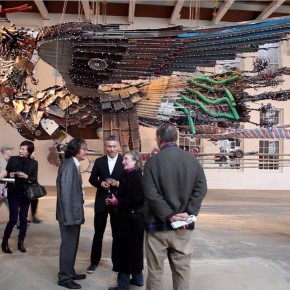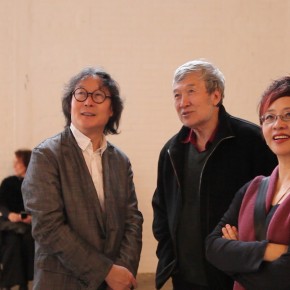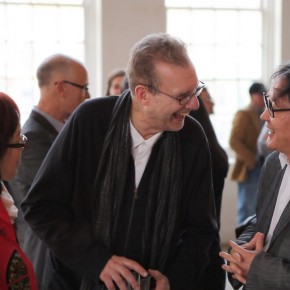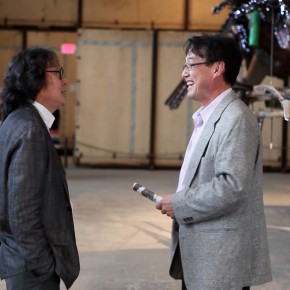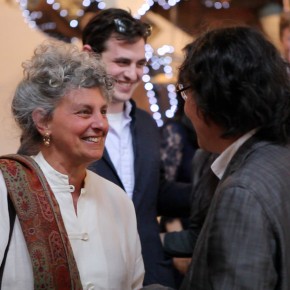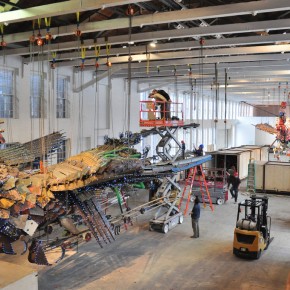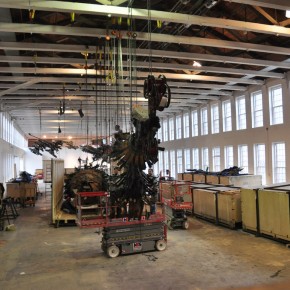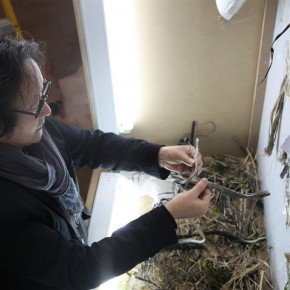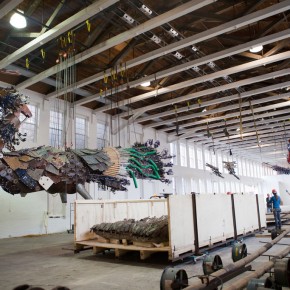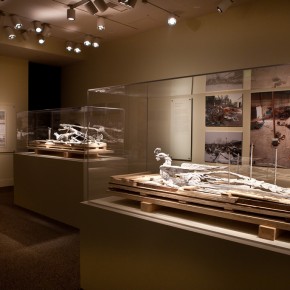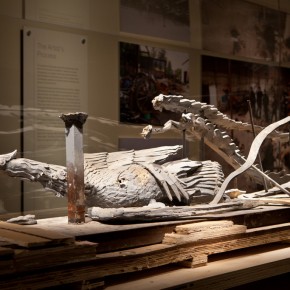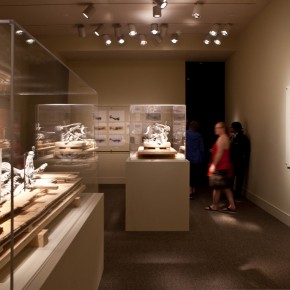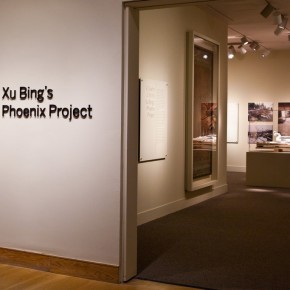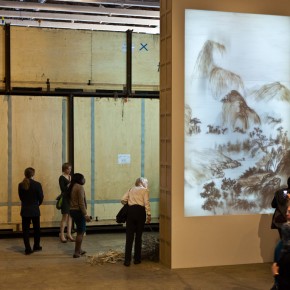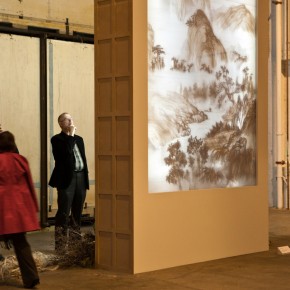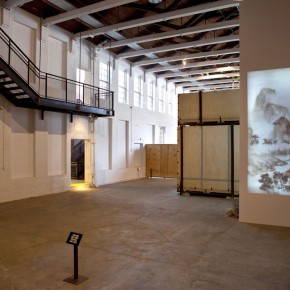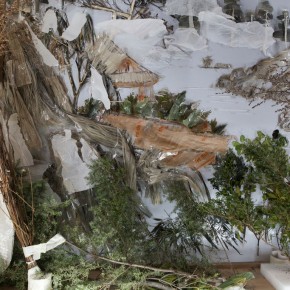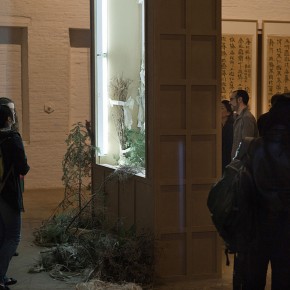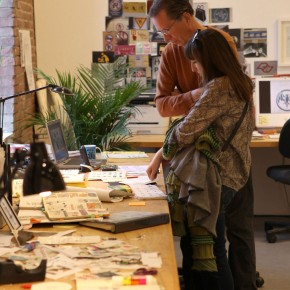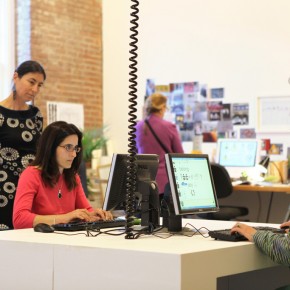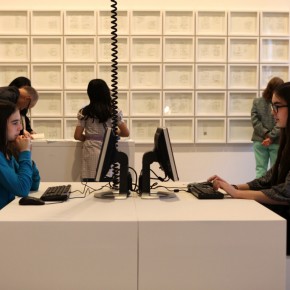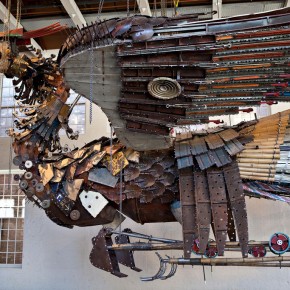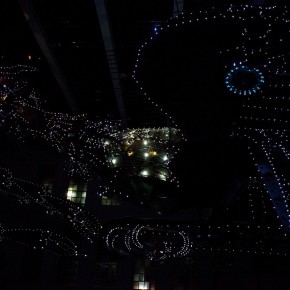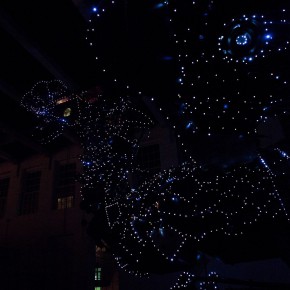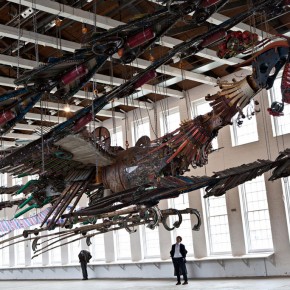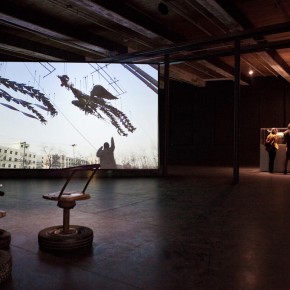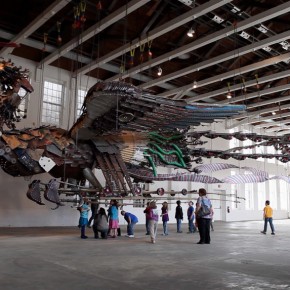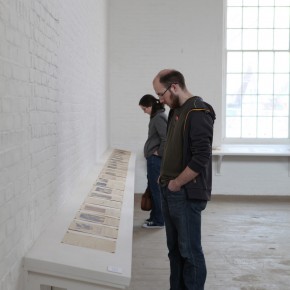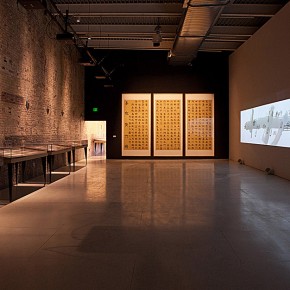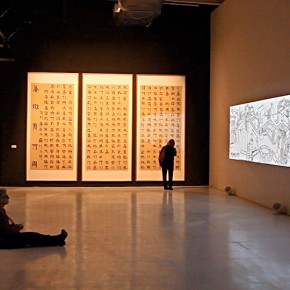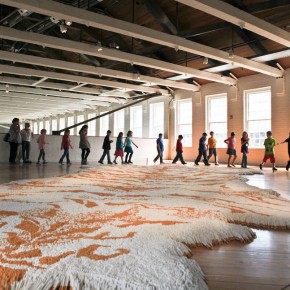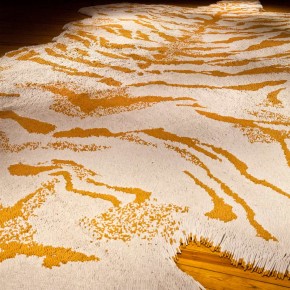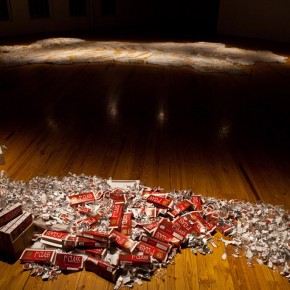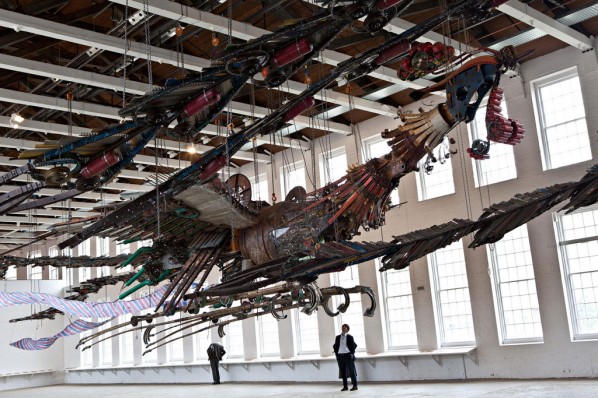
First time controversial sculpture fabricated from Beijing construction debris to be presented outside of China
North Adams, MA---Phoenix Project, two spectacular and massive birds fabricated with construction and demolition debris from Beijing, is shown in their premier exhibition outside China as the dramatic centerpiece of a major exhibition of Xu Bing's work on view in MASS MoCA's signature space -- Building 5. Installed in the 300-foot main gallery, the two great phoenixes -- each nearly 100 feet long and weighing nearly 20 tons in all -- were inspired by the artist's observations of the dramatic changes in Chinese society upon his return from a long stay in the United States. The multitude of glass skyscrapers rising in the major urban centers was a potent symbol of China's rapid accumulation of wealth and its astounding new development. Xu spent two years creating the mammoth birds, collecting and purchasing materials from construction sites in Beijing between 2008 and 2010.
Steel rebar, bamboo scaffolding, conduit, shovels, hard hats, gloves, and other evidence of labor (and demolition) form the body, feathers, and talons of these mythical birds. Engaging both capital and labor in a practice that paralleled Beijing's urban redevelopment, the massive sculptural works were fabricated by a team of workers, with complex financing. After the 2008 Beijing Olympics and the ensuing global financial crisis, and as the potentially controversial meaning of both the work and its means of production became apparent, financial and logistical support were withdrawn, which forced the artist to continue production through alternative means. The grand, raw energy of the work, together with its distinctly Chinese mode of creative production, caused Phoenix Project to be labeled "an artwork almost too vivid in its resemblance to contemporary China."
Widely considered to be among the most important Chinese artists working today, Xu describes the exhibition, which he titled simply Phoenix, as one which -- like the sculptural birds -- exemplifies his interest in re-using, adapting, and transforming materials and meaning. A concise suite of additional works will illustrate the major themes of Xu's practice, including the capacity and limits of language, the nature and intricate forms of human exchange, and the dynamic interplay between economic development and social justice. In addition to the phoenixes, the exhibition includes a major new shadow-and-light-box commission from the artist's Background Story series, and a large sculpture from his Tobacco Project (1999-2011). In April, the show will expand to include an interactive installation from the artist's continuing work of research into human communication, Book from the Ground (2003-present), along with Square Word Calligraphy (1994-present), the artist's witty blend of Chinese and English, among other works.
At MASS MoCA, the centerpiece phoenixes is suspended in flight from overhead trusses; dwarfing visitors, the male phoenix Feng measures 95 feet long, while the female Huang reaches nearly 100 feet in length, beak to (steel) tail feathers. Both are internally lit with thousands of L.E.D.s; the birds glow like a constellation when viewed at night. Stunningly beautiful, richly textured, and at times almost brutally authentic, the Phoenixes bear witness to the complex interconnection between labor, capital, tradition, and commercial development in today's China.
This is the sculptures' first appearance outside China where they were shown in truncated exhibitions for just a few short weeks. The two huge birds briefly graced an outdoor space at the Today Art Museum in Beijing's Central Business District and the Baosteel Stage at Expo 2010 in Shanghai. Originally commissioned for the glass atrium connecting the two towers of Cesar Pelli's World Financial Center in Beijing, the works raised difficult questions in China (and were left without a permanent home), drawing attention as they do to both the laborers who built them and the demolition of old neighborhoods that are often quickly and unceremoniously razed to make room for new construction in rapidly growing Chinese cities. The completion of the work was ultimately made possible by its owner Barry Lam, who has generously lent the work for this exhibition.
Xu explained the origin of the piece in an interview for The New Yorker: "I went to a construction site and I was shocked. China has so many modern buildings, but you can't imagine how poor the working conditions and primitive living situations were. I think there is a huge contrast. That was when I decided to use waste materials. I wanted to use the waste materials from the building construction to create a piece of work that hangs inside the building itself. I thought that could have meaning, because this new building was extravagant. As I saw it, using garbage and construction waste to make a piece of work would make the building look even more extravagant. They complement each other. The material would make the building look grander, and this grandeur would make the phoenixes look even rougher and more authentic."
In East Asian culture, the phoenix has multiple meanings, ranging from imperial power to prosperity and eternity. It is the most respected creature of Chinese legend after the dragon. Often paired with the male dragon, the phoenix is understood to be a feminine creature, and together the two symbolize a perfect marriage. In the Han dynasty, however, the phoenix was often depicted in male/female pairings, like those in Xu Bing's work. Unlike the Western myth of the phoenix in which the miraculous bird arises re-born from the ash, in Asia the phoenix is not associated with destruction and rebirth, at least in its earliest incarnations. Xu Bing's work often plays with notions of translation and mis-translation in language and across cultures; the phoenix thus offered the artist a rich range of mythological and visual expressions that he could draw upon to reconfigure an important -- and continuously evolving - -Chinese symbol.
The artist's appropriation and re-contextualization of familiar images and icons are seen in additional works in the exhibition. On entering the museum gallery, for example, visitors will encounter a large vertical light box that at first appears to contain a traditional Chinese hanging scroll painting of a landscape. Going behind the work, however, viewers are shown the means of the artist's illusion. Xu has left visible the collection of trash, dried plants, and other debris carefully arranged against the back side of frosted glass panels and whose silhouettes and shadows create the image of a classic Chinese landscape. Xu has made a replica of an existing work, re-creating not only the mountains and trees, but also the ink washes, lines, textures, and brushstrokes of the original. The artist sees these works as a dialogue with the artists who have come before him and has also compared his method of working to painting with light instead of pigment.
1st Class (2011), originally created for Xu Bing: Tobacco Project at the Virginia Museum of Fine Arts is also on view. The faux tiger skin -- made with approximately 500,000 cigarettes arranged so that the white papers and tan filters create the look of the animal's stripes -- is a recognizable symbol of Colonialism and luxury in Asia. Xu's version references the history of the global tobacco trade, both its role as a boon to many economies and its complex position in society and in our psyches, as a much-loved indulgence and a pernicious threat to health. Rounding out the suite of works is a film documenting the production of the phoenixes, which will provide insight into their conception and birth.In the spring, timed to coincide with a companion exhibition organized by the Freer | Sackler Gallery of the Smithsonian Institute, the MASS MoCA exhibition is augmented to include Book from the Ground (2003 - present), an interactive and constantly evolving installation which recreates the artist's studio space and his growing collection of pictographic symbols from around the world. The index of recognizable icons, culled from airport signage, consumer packaging, social networking tools, and from disciplines as varied as math, science, and dance, are meant to be readily understood by people across cultures and of varied educational backgrounds. The work is related to the artist's work Book from the Sky, made over 20 years ago. That monumental installation is composed of books and scrolls printed with what appear to be traditional Chinese characters but are in fact illegible characters wholly invented by the artist. The early work exposed the limits of the written word as a primary vehicle of communication and addressed its tendency to divide people. Conversely, Book from the Ground is a text completely written with universally understood pictograms and points the way to a potential language of the future, one which unifies rather than excludes and segregates.
Visitors to MASS MoCA's Xu Bing: Phoenix are encouraged to view a related exhibition at the Arthur M. Sackler Gallery in Washington, D.C., which will feature preparatory materials related to the phoenixes, including drawings, scale models, and reconfigured construction fragments, along with works from the museum's extensive collections that place Xu Bing's Phoenix Project into the context of the use of the phoenix and other mythological creations throughout Chinese culture and history. On view at the Sackler Gallery from late April through September 1, 2013, the exhibition traces the evolution of the monumental sculptures while exploring Xu's poetic re-imagination of an ancient Chinese motif to address contemporary social concerns. The two exhibitions will be complemented by special online features and public programs. The Sackler Gallery, which along with the Freer Gallery of Art constitutes the Smithsonian's museums of Asian art, has a long relationship with Xu Bing. The 2001 seminal exhibition Word Play: Contemporary Art by Xu Bing at the Sackler Gallery also drew upon the museum's collections to enhance understanding of the traditional Chinese cultural forms central to much of Xu's work. In honor of the Sackler Gallery'ss 25th anniversary celebration in late November, visitors will be able to preview the scale models of the phoenixes for a limited time. For more information visit asia.si.edu/sackler25.
Born in Chongqing, China, in 1955 and raised in Beijing. Xu worked in the countryside during the Cultural Revolution, then studied drawing and printmaking at the Central Academy of Fine Arts in Beijing. He gained international recognition in the late 1980s with Book from the Sky. Xu Bing moved to the United States in 1990 in the wake of the events in Tiananmen Square. In 1999 he was awarded a MacArthur Fellowship for his "originality, creativity, self-direction, and capacity to contribute importantly to society, particularly in printmaking and calligraphy." He returned to China at the end of 2007 to take the position of Vice President of the prestigious Central Academy of Fine Arts, Beijing, and to devote himself to promoting the development of Chinese contemporary art. His work has been exhibited in China, Japan, Australia, the United States, and all over Europe. Xu's notable public commissions include works for the Arthur M. Sackler Gallery, in Washington, D.C., and at the I.M. Pei-designed Chinese Embassy, also in Washington, D.C.
Phoenix Project was commissioned by Ravenel Art Group and is on loan courtesy of the collection of Mr. Barry Lam. MASS MoCA is grateful for additional exhibition support provided by the artist's studio; JUT GROUP; Beautiful Asset (Beijing) Industry Co., Ltd.; Eslite Gallery; Horace W. Goldsmith Foundation; Massachusetts Cultural Council; Helen & Will Little; and an anonymous donor.About the exhibition
Date: December 22, 2012, through October 31, 2013.
Venue: MASS MoCA's signature space -- Building 5.
Tickets are free for members and invited guests, or $8 for not-yet-members. For further information please contact Rebecca Wehry at (413) 664-4481 ext. 8157 or emailing rwehry@massmoca.org.
Courtesy of Xu Bing Studio, for further information please also visit www.xubing.com.


